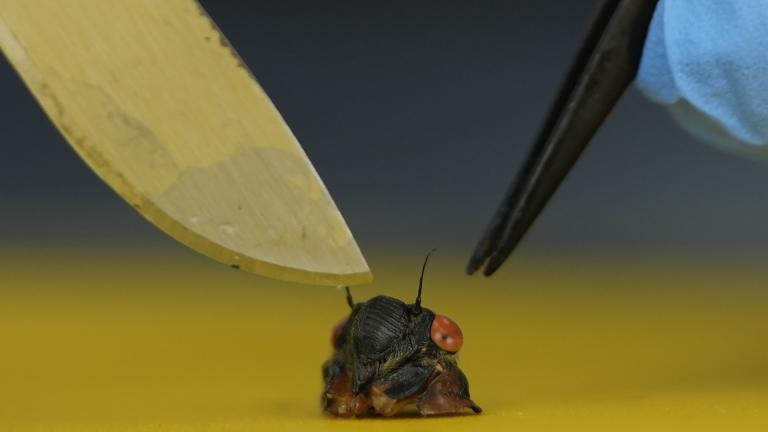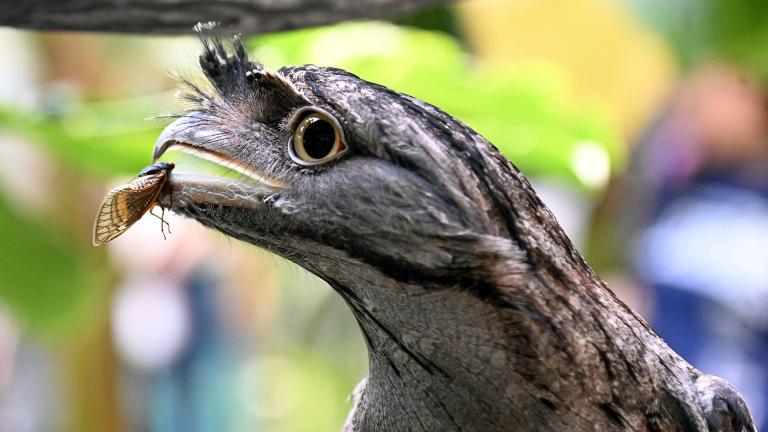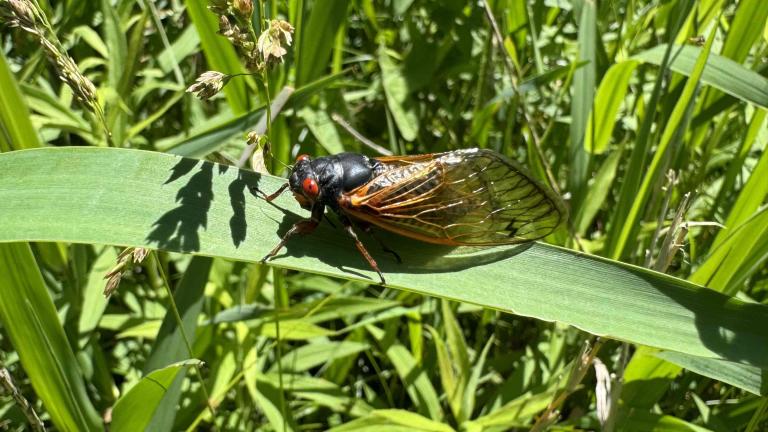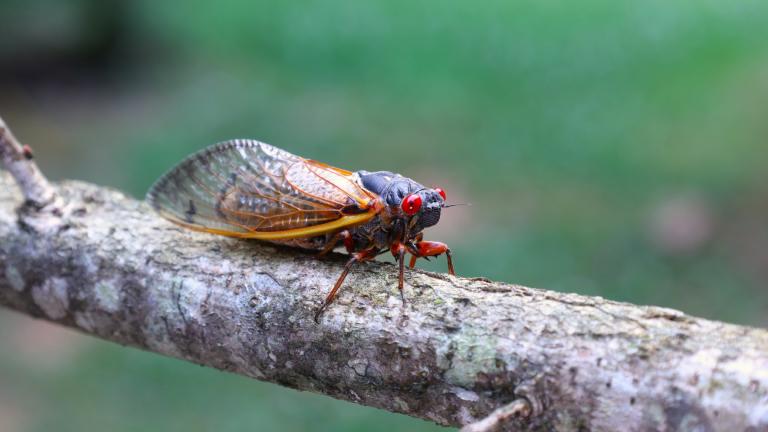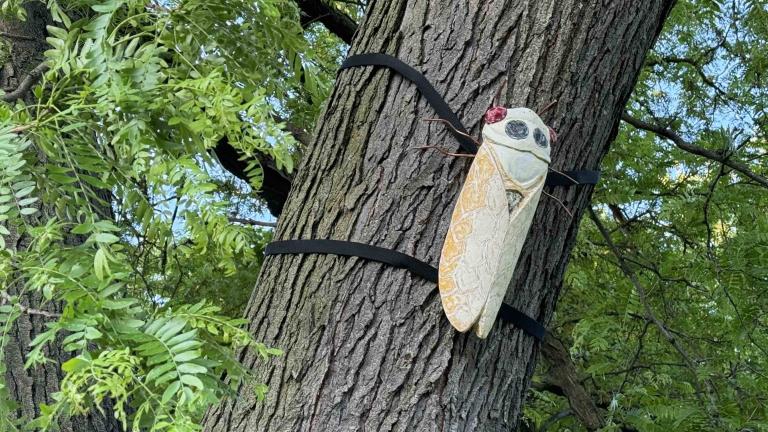(Video produced by Nicole Cardos)
The Field Museum has more than 10 million specimens in its insect collection and — believe it or not — not a single 13-year periodical cicada among them.
So what better time than now to fill that gap, with Illinois experiencing a dual emergence of 13-year and 17-year cicadas that hasn’t been seen in more than 200 years.
Given the rare opportunity to conduct fieldwork close to home, a small group of museum staffers, led by insect collections manager Maureen Turcatel, recently went bug hunting in the Champaign-Urbana region.
Acting on a hot tip from the Forest Preserve District of Champaign County, the Field team headed to Middle Fork River Forest Preserve during the last week in May.
“What they told me is that at this location specifically they identified species of both groups, the 17-year and the 13-year,” Turcatel said.
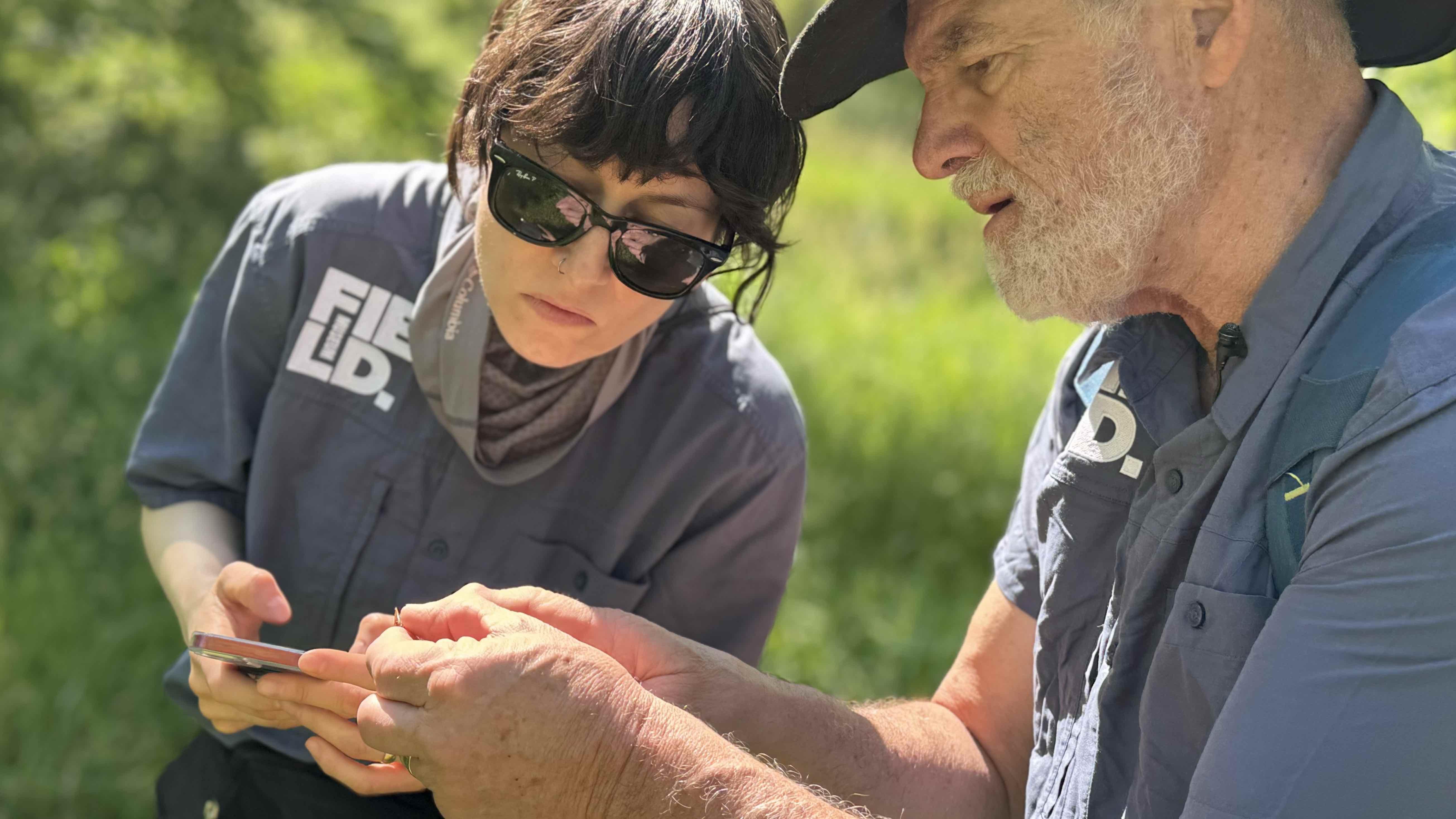 The Field Museum’s Maureen Turcatel and Jim Louderman examine a cicada specimen to add to the Field’s insect collection, May 30, 2024. (Patty Wetli / WTTW News)
The Field Museum’s Maureen Turcatel and Jim Louderman examine a cicada specimen to add to the Field’s insect collection, May 30, 2024. (Patty Wetli / WTTW News)
The group arrived mid-morning just as the sun-warmed cicadas were growing active, buzzing in the tall grasses and erratically flying toward the tree tops in that classic cicada drunken-toddler flight pattern.
For Turcatel, a native of Brazil who’s lived in the U.S. for more than a decade, it was her first close encounter with a cicada swarm.
“This is the first time I’m somewhere where the emergences are occurring,” Turcatel said. “So it’s pretty special to be in Illinois when you have both of them occurring at the same time. I (live) in the city, so we’re not seeing it. We took a drive to some friends’ houses, and we could see a little bit over Memorial Day weekend but nothing like this. This is way more than what we saw.”
By day’s end, the team hoped to have filled their glass jars with as many as 30 live members of each of Brood XIX’s four cicada species, and maybe some of Brood XIII’s 17-year cicadas for comparison. (There are three species in Brood XIII, just to further complicate things.)
Catching live cicadas is better than gathering samples of dead insects, explained Jim Louderman, longtime insect collections assistant at the Field.
“(Dead ones) are really not of much value because they’re all dried out and crinkly,” Louderman said. “You can’t get much in the way of DNA out of them.”
“They could be slightly decomposed,” Turcatel interjected.
“They’re nasty, basically,” Louderman continued. “They don’t work in a collection, they don’t work for DNA. So you want to get ones that are alive and either put them directly in alcohol or freeze them to preserve the DNA.”
Louderman even had a liquid nitrogen container in his trunk to flash-freeze specimens, which would also preserve RNA.
And yes, collecting does ultimately mean killing the insects in the name of science.
“There are so many of them (cicadas), maybe the couple hundred that we will collect will have zero effect on the population,” Louderman said.
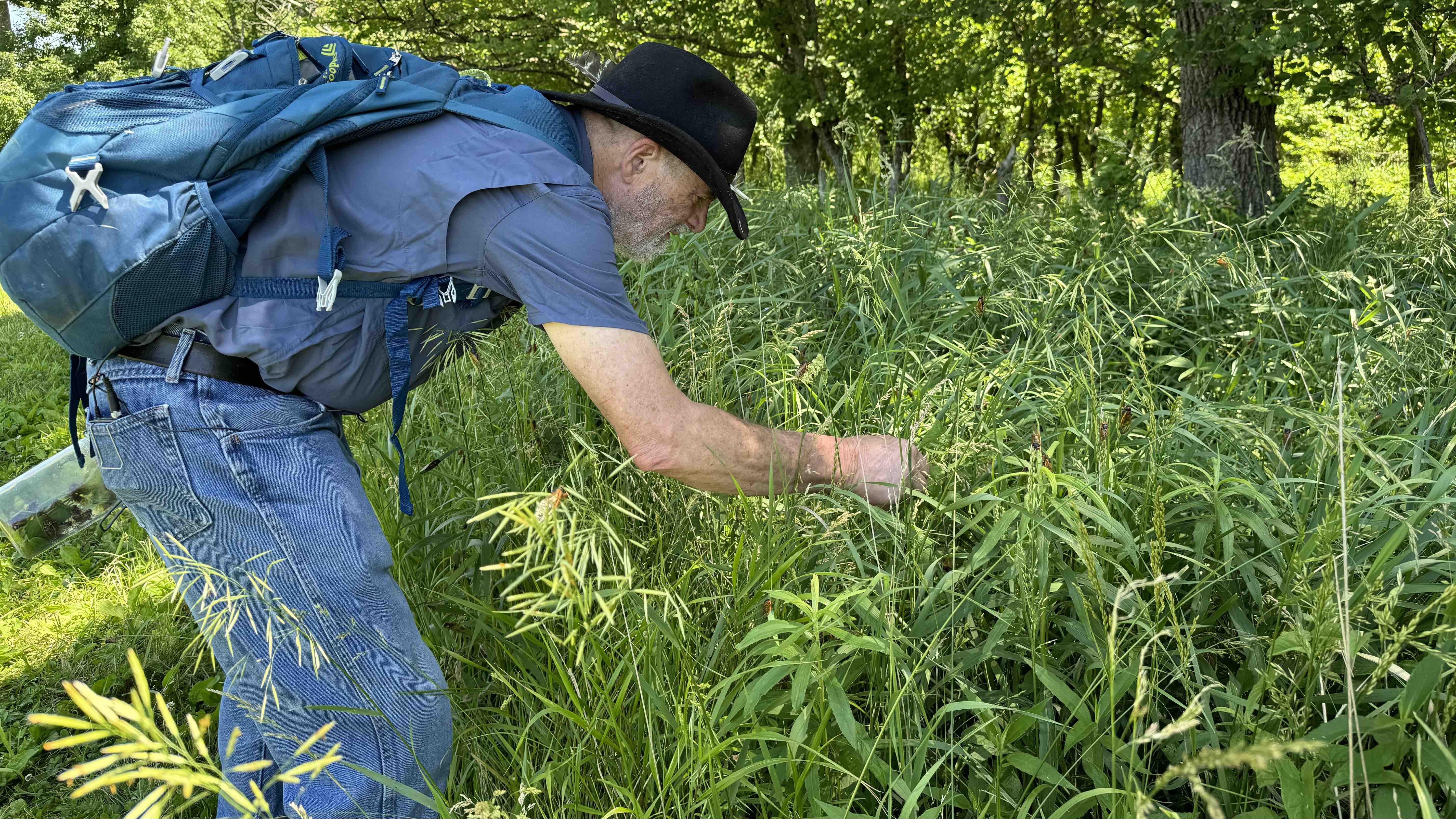 Jim Louderman on the hunt for cicadas to add to the Field Museum’s insect collection. (Patty Wetli / WTTW News)
Jim Louderman on the hunt for cicadas to add to the Field Museum’s insect collection. (Patty Wetli / WTTW News)
As bug hunting goes, cicadas make for easy pickings.
“They are big, they’re fairly slow, we can just grab them with our bare hands,” Turcatel said. “They’re not going to sting, they’re not going to bite. It’s very safe for us to handle them directly. For other insects, we might need to use the insect nets or aspirators or traps, but for cicadas specifically, we can just grab them with our own hands and just put them in our vials.”
Not to mention they were everywhere, doing all the cicada things — mating, laying eggs and landing on people’s shoulders, legs and hats. The males’ combined chorus rivaled but didn’t quite drown out the drone of a nearby forest preserve mower.
Turned out, the relatively cooler temperatures, right around 70 degrees, weren’t optimal for maximum racket, said a disappointed Louderman.
Video: A Field Museum researcher pinpoints the parts of the cicada worth paying attention to. (Patty Wetli / WTTW News)
The trickiest part of the collection process wasn’t so much nabbing a cicada as it was nabbing a species that hadn’t been grabbed dozens of times already.
The differences between the species — Magicicada tredecim, Magicicada neotredecim, Magicicada tredecassini and Magicicada tredecula — are subtle and mostly based on color.
“The easiest way for most of the species is just to flip them over and see the markings on their abdomen,” Turcatel said. “Some are going to have orange stripes, some of them have all-black abdomen, there’s some variation in size.”
Fifteen or 20 minutes into the hunt, it was clear the all-black tredecassini was the dominant species on site. Grab, flip, “cassini.” Grab, flip, “cassini.”
Louderman added grass to the increasingly crowded cassini jar for the insects to crawl on, “so they won’t beat each other up.”
Cicadas with anything remotely resembling stripes were brought to Louderman and Turcatel for closer inspection. How thick were the bands? How deep was the orange?
IDs made in the field would be confirmed later in the lab, either by matching specimens against descriptor keys, dissection or DNA extraction if necessary, Turcatel said.
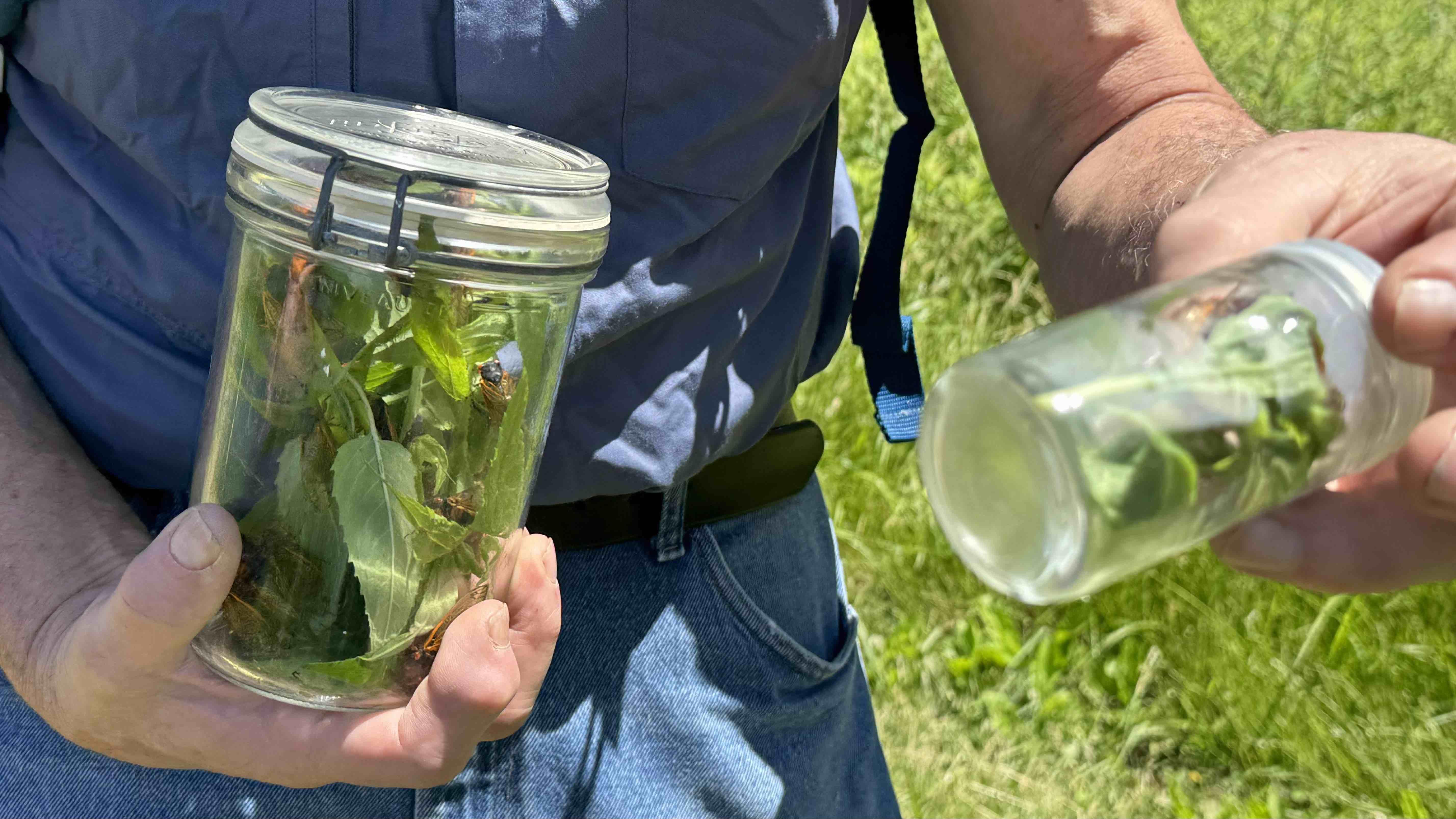 Specimens were placed in jars according to species. (Patty Wetli / WTTW News)
Specimens were placed in jars according to species. (Patty Wetli / WTTW News)
By lunchtime, the team was satisfied with its haul: specimens of every 13-year species, plus some suspected 17-year, along with a rare blue-eyed cicada and a several fungus-infected cicadas.
A couple specimens of each species would likely end up pinned in a tray with other cicadas, kept in an entomological drawer, while the rest were destined for the Field’s DNA and RNA study collection, all of which are accessed by scientists around the world.
“We can do all kinds of stuff: What causes the blue eyes? What causes the fungus that’s on them?” Louderman said. “Because it’s only once every 13 or 17 years, we don’t know a whole lot about the fungus or about cicadas themselves. It’s a lot of new ground being covered, because now we have so much better DNA work that we can do.”
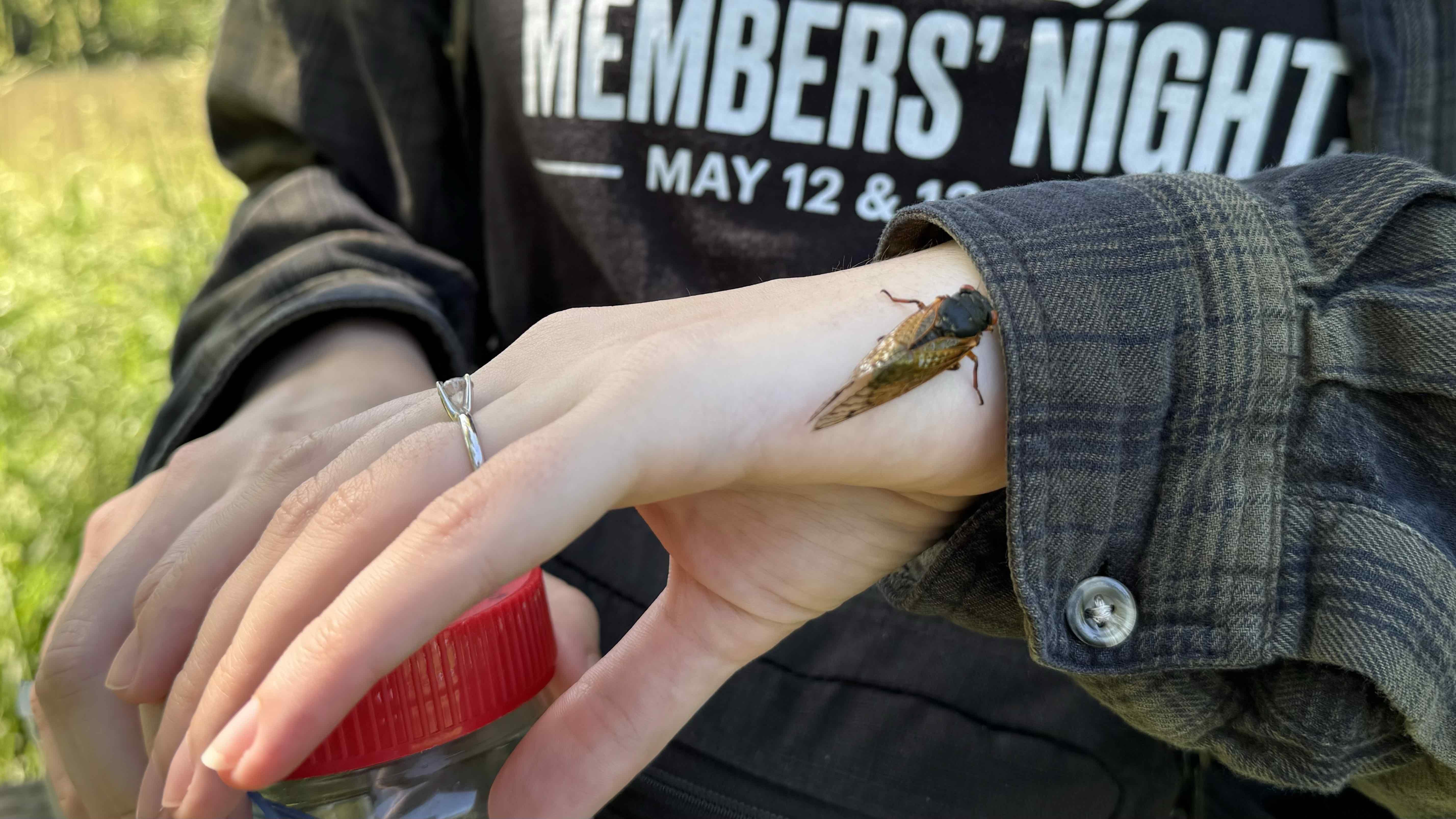 As bug hunting goes, cicadas make things easy. (Patty Wetli / WTTW News)
As bug hunting goes, cicadas make things easy. (Patty Wetli / WTTW News)
And who knows what future tools scientists will have at their disposal to unlock information from specimens?
“There is even information in the species that we might not even know that exists yet,” Turcatel said. “One example of why keeping collections is important is very recently we started talking about microplastics in the environment. And some scientists were able to trace when microplastics became a problem in a given region by going into the collections and testing what was preserved. So if people were not collecting, if people were not preserving, there was no way we could ever tell that was a problem and when it started.”
Could cicadas hold the key to a cure for cancer?
Probably not, Louderman said, but what if they did?
“We don’t know at this point, so that’s another reason for keeping things for DNA,” Louderman said. “We have no idea what could end up being the final outcome of these insects.”
Contact Patty Wetli: @pattywetli | (773) 509-5623 | [email protected]

